The Rama are said to be the Guardians of the Forest. These indigenous people of Nicaragua live in one of the most remote corners of the country, in the Reserva Biológica Indio Maíz. This beautiful, untouched land and its interesting people are hard to reach, but the journey will be worth the effort.
There are few Native Indians left in the world, who are still living in their ancestral environment and who try to protect their lands as powerfully as the Rama. So strong is the love of the Rama for their native rainforests that without a second thought they can reject millions of dollars and big, multinational corporates as well as international scientists. All without a blink of an eye, if they think the people would hurt their lifestyle or the surroundings. In the ideology of the Rama the rainforests are not made for humans to only benefit from – instead, we should live in the forests, in harmony.
The Communities and the life of the Rama
Today about 50 families are living in the area of Greytown and Rio Indio in the Indio Maíz. Canta Gallo is a relatively new settlement concentration. It can be reached by a small motor boat in approximately 8 hours from San Juan de Nicaragua/Greytown. It’s so deep in the jungle that no cell phone will work since the last mobile network tower is located in San Juan de Nicaragua. You will be completely disconnected.
Moreover, the biggest Rama community is in Bluefields, where’s also located the world’s only Rama University. There was also Makenge – a town, which used to be the biggest Rama habitat center in Indio Maíz. Our guide, Salomon, was originally from Makenge, too. Until the early 21st century there was also a first-grade school in Makenge for the children of the Rama, but the Nicaraguan government shut it down.
This brought many problems to the Rama community. Since then the parents have been struggling to get at least some education for their children because it’s very expensive to send children to school a long way away and the Rama are generally penniless. The government pays petite attention to the Rama issues, although nowadays the situation may have improved a bit. But still a new school hasn’t been built, for example.
After the school had been suppressed, Makenge started to die. Until 2003 there were still 5-10 families living in Makenge, our guide Salomon being one of them. But eventually, they all moved to Greytown/San Juan de Nicaragua, because it was too expensive to live so aloof. However, some Rama has always lived in the Indio Maíz, scattered around, and they have just refused to move into the town.
Life really isn’t easy in the jungle – many of the Rama still use the traditional canoe, carved out from a single log of a tree. With such canoe, it takes 12 hours to paddle from the area of the old Makenge to Greytown via the Rio Indio. This is a long journey to take every time they’ll need some food and other equipment from Greytown, and many of the people live much further away than Makenge. We actually saw few of these canoes making the journey while we were visiting in the Indio Maíz and you couldn’t but admire the people. Not only for their exceptional persistence, but also for their determination for preserving their unique culture.
In addition to the community in Canta Gallo, the Rama have also started to build a new settlement called the “Holy Land.” This little village is presumably in the same area where the old Makenge was, even though the actual location of Makenge was left a bit undefined in our guide’s stories. There’s a small concentration of families living around, and they’ve even built a new Communal House. So maybe that community area is slowly starting to thrive again. A good sign for the revival of the Rama habitat in Indio Maíz.
Life really isn’t easy in the jungle – many of the Rama still use the traditional canoe, carved out from a single log of a tree. It takes 12 hours to paddle from the area of the old Makenge to Greytown.
Life of Tradition of the Rama
The tradition lives firmly among these indigenous people. For example, most of the Rama live in traditional houses, built from wood and other materials got solely from the forest. The houses are also very primitive, consisting of just the essential parts. There’s an open communal area with hammocks, a covered sleeping area, and an open kitchen. Below the floor is where the animals are kept – mostly chickens. The only toilet is the nature behind the house, and if you want to shower – well, there is the river. But you have to be very careful because there are crocodiles in the river!
Some modern things the Rama have adopted, though. They have solar panels to produce the little electricity they need for the lights and maybe for a radio or a TV. Even though they don’t have much, these people were some of the most friendly I’ve ever met. It was an honor to have the privilege to spend a night in an original Rama house. Sleeping in the hammock on the open porch, in the middle of the jungle, was an experience you just cannot forget. Pitch black darkness of the night and all the sounds of the vast jungle around you. It was a bit scary, but soothing at the same time.
As mentioned before, the Rama are “the Guardians of the Forest” and they know a great deal about the rainforest. Even today, Shamanism has a lot of footing in the Rama communities. When it’s at least a half day’s journey to the nearest doctor, sometimes the knowledge of which plant may save you – or at least give you some first aid – may turn out to be invaluable.
Salomon showed us a mushroom, which can ease snakebites, as an example. We asked him that if something severe happens, like a crocodile bites you, do you have a chance to survive? He was quiet for a while, then looked at us with a troubled face and said: “If you are lucky.”
The jungle hides many other things besides dangers and medicinal plants. We visited the sacred Rama pyramids of Canta Gallo, and they’re not the only secrets of the Indio Maíz. Many stories are told about the spirits of the jungle, who protect certain areas.
Commonly known is a story of one army group who were supposed to clear off a part of the jungle for a government project, but ended up shooting each others to death when trying to evict the attacking jungle spirits who protected their forest.
“There are areas where only the Rama can enter,” our other guide to the pyramids, Margarito, told us. These areas are a significant part of their culture, and maybe they are guarded not only by the Rama but the fierce jungle spirits as well.
The Dying Rama Language
The original Rama language has almost died away. Only 1% of the Rama can speak it. Some say that there are only 24 elderly people left who can speak it fluently. It’s a verdict of disappearance, despite some recent language revitalization efforts in the last few years. Even our Rama guide Salomon admitted that he couldn’t have a fluent conversation in Rama anymore, despite him being a bit elderly already. A language is a big part of cultural identity, and therefore, I wish that despite all the odds, they would succeed in preserving the Rama language – a part of the Chibchan languages. Maybe this Rama language project will help, at least a bit.
Nowadays most of the Rama speak “Rama Cay Creole,” a strange English mixed with some words of Spanish and Rama into it. It sounds peculiar, and your ears have to get used to it first, but since it’s mostly English based, you can get along just fine.
We asked our guide, Salomon, that if something really serious happens deep in the jungle, like a crocodile bites you, do you have a chance to survive? He was quiet for a while, then looked at us with a troubled face and said: “If you are lucky”.
How to Arrange a Visit to the Indio Maíz and the Rama Indians?
The best option to organize a visit to the dense jungles of Indio Maíz and to meet the Rama is when you’re already in San Juan de Nicaragua. We couldn’t find any websites from where you could book a tour beforehand, at least not any reliable or convincing ones. I also strongly recommend booking your visit from San Juan de Nicaragua/Greytown for a reason.
There were lots of companies offering an Indio Maíz tour in El Castillo, but if you want to have a genuine, authentic and truly individual experience, along with supporting the Rama community directly without any intermediates, you shouldn’t book your tour from El Castillo. Also, the journey to the heartlands of Indio Maíz from El Castillo is really long, to the extent that it can be quite exhausting. Make the effort, travel all the way along the Rio San Juan to Greytown/San Juan de Nicaragua. Trust me; it will be worth it!
When in Greytown, ask for your accommodation to arrange you a tour to Indio Maíz or ask around the village for Rama guides. If you speak at least a little bit of Spanish, it’ll help you a long way. Note that only Rama Indians are allowed to take visitors into the Indio Maíz! Our Hospedaje arranged us to meet our guide; the Rama Indian called Salomon, with whom we visited the Reserva Biológica Indio Maíz. We spent a homestay with a true Rama family and had a hiking tour to see some thousands of years old pyramids, deep in the jungle.
We had a one night’s trip, including everything (the tour, transportation, guides, accommodation, food, some drinking water). We paid 200$ for the two of us. The price can vary between 200-400$ (for 2 persons) depending on how many nights you’ll be staying and with what kind of boat you’ll be traveling.
Gas is expensive in Nicaragua, and you’ll have at least 6-8 hours’ boat ride into the jungle Reserve, so there actually won’t be much profit left for your guide(s) and the Rama community. Just in case if you think that the tour is expensive – it’s not! Salomon was a great and professional guide. I can warmly recommend to take him as your guide if you’re able to. He can take you further into the jungle than the other well-known guide, Alicia McRea, who usually makes her tours only as far as the old Makenge. And somehow, after meeting Alicia in person, I also believe that Salomon and his son, Norvin, will give you a more thoroughly, deeper and personal experience of the magical Reserva Biológia Indio Maíz.
(text: Piritta / photos: Niina / photo edits: Piritta)
You May Also Like to Read:
How to Organize a Trip to Indio Maíz, Nicaragua
Venture deep into Indio Maíz jungle with Rama Indians, stay in the traditional Rama home, and hike to the sacred pyramids of Canta Gallo.
Canta Gallo – Ancient Rama Indian Pyramids Deep in the Indio Maíz Jungle, Nicaragua
Some call it a lost city of ancient Indians, the others claim the pyramids are millions of years old. We traveled deep in the jungle with Rama Indians to hear some unbelievable stories and spot poisonous animals while exploring these stunning grounds.
San Juan de Nicaragua a.k.a Greytown – A Gateway To Indio-Maíz
This remote town with concrete pathways, three different names and four old, little graveyards is a great gateway to Reserva Biológica Indio-Maíz, the best jungle of Central America.
Landing to San Juan de Nicaragua [Video]
Landing to the jungle airport of San Juan de Nicaragua with a 12 seat Cessna.


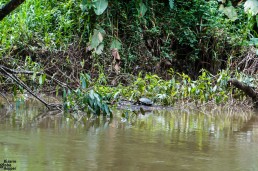
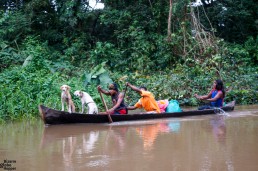
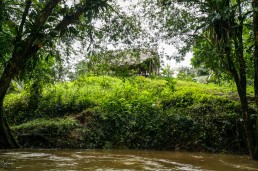
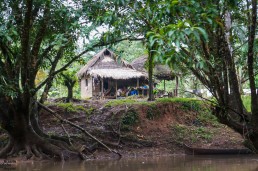
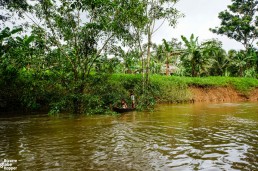
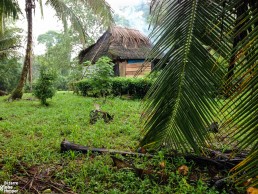
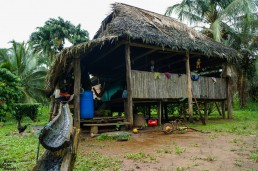
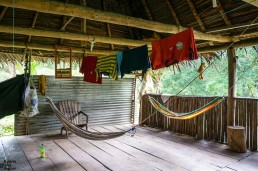
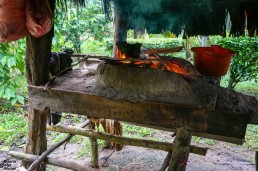
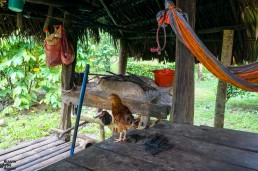
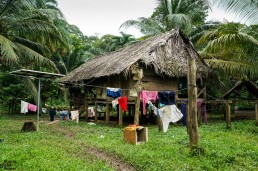
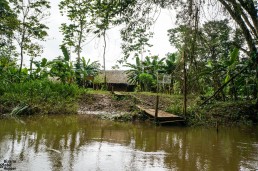
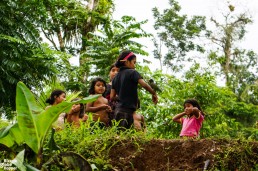
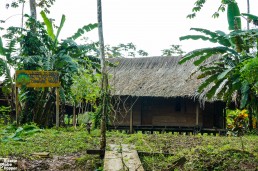
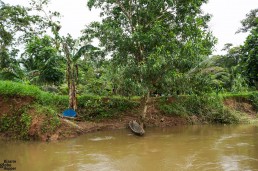
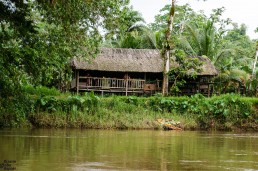
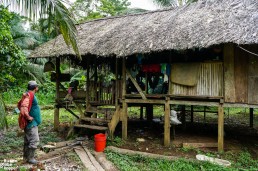
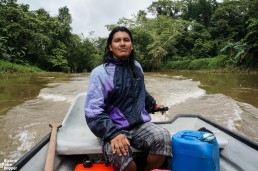
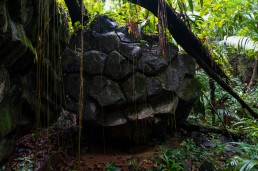
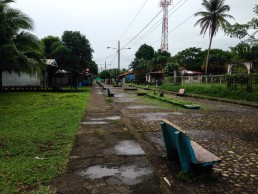

Nicaragua became an interesting place to me after reading this article. I will definitely visit
Hi and thanks for stopping by! Great to hear that you’d like to visit Nicaragua after reading my article! 🙂 That’s exactly what I want to do; inspire people to go on new adventures! I wholeheartedly recommend visiting Nicaragua, it’s a very interesting and beautiful country and getting to know the Rama culture more, please visit Reserva Biológica Indio Maíz, too. I’ll be worth it – I guarantee! 😀
I absolutely love your content and style of writing. As a fellow adventurer, I appreciate the reality that you interject into your posts. I was especially intrigued by your piece on the Canta Gallo, and it’s potential ruins.
I am currently preparing to send my first- ever submission to an online magazine. The article is about the Canta Gallo, and whether the site is a natural geologic formation, or a man made artifact.
I would like your permission to use one or two of your photos in my article. They would provide the anchor point for the article, and support the other geologic photos I will use to make a comparison between natural and artificial structures.
If you would be so kind as to grant me permission to use your photos, I will be greatly appreciative.
Thank you for your time and consideration.
Sincerely,
Robert Bowers
I saw that you recommended to plan the trek once you arrive in Greytown. How did you organize the boat ride from the airport to the town beforehand? Where did you stay exactly?
Thanks!
Danielle
Hi, Danielle! We stayed first in Hospedaje de la Família and they were supposed to pick us up from the airport though that didn’t go exactly as planned. They ended up taking the other two guests and leaving us behind. We eventually got a ride to town from the airport staff when they left home. If you want to book a room with Hospedaje, you have to call. They had no email address (at least not back then) and they speak only Spanish. We stayed a night also in Jardín de Ramas and their cottages were nice.
Hi there! I’m doing a project for my Spanish 3 class and would like to know if it is okay if I use a few of your photos, since they are authentic (I will provide proof of giving uou credit when it is done, if that is ok.) . I am doing it for my assigned country, Nicaragua, and chose the Rama people. 🙂
Hi Alora, and thanks for your message! I’m glad to know that you’ve found my Rama article useful and flattered to know that you’d like to use some of my pictures. I have dropped you an email for more details.
Nicaragua is beautiful and interesting, especially when one has time and interest to learn the history of the place. I lived in Bluefields, Nicaragua for about 7 years in the late 80’s and early 90’s. A young man, Creciendo Alejandro Saloman who graduated High School in Bluefields in about 1997 could be a helpful guide for visitors to Rama Cay. Try this phone # for him in Bluefields (505) 87475347.
Careful tourists to Nicaragua and especially Bluefiels and the Caribbean Coast can learn a lot about the country if you chance to meet with a group of well-educated young people (in their 30’s, 40’s)who are currently active in upgrading/expanding sports activities for youth and active adults in Bluefields. Thinking travelers who might be tempted to discount Bluefields while flying directly to the Corn Islands will be missing out. Inquire at CEDECA in Bluefields, if I have whetted your appetite for a positive experience with the well-educated, good hearted group of folks I know there. And Do Not miss having a great meal at Luna Ranch Restaurant just down the hill from the URACCAN university campus : Carlos Eddy Monterrey and his wonderful wife will feed you well!
Really interesting incite, thank-you! I’d love to spend some time in Nicaragua next time I make it across the Atlantic.
Hi Katie, and thanks for your comment. I’d recommend whole-heartedly to go to Nicaragua, it was a blast! A great country in general with a lot to offer. Above all, don’t skip the Reserva Biologica Indio-Maíz, it was one of the best places we visited!
Totally absorbing and fascinating. Thanks for sharing this amazing adventure. We are currently in Mexico City but soon making our way to Nicaragua. I am making this my first stop. Amazing.
Hi Anna! Thank you very much for your comments. Indio Maíz was phenomenal, totally worth all the effort to get there! Was also great to meet the Rama. Enjoy your trip, hope you’re going to have amazing time there! We’d also love to hear how it went. Safe travels!